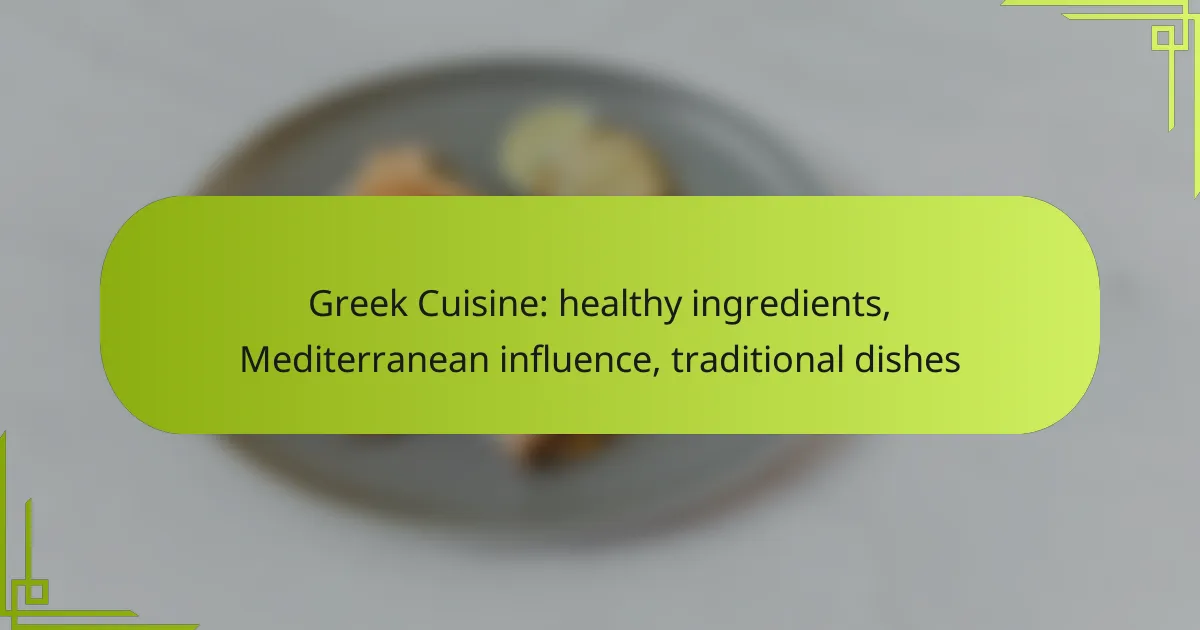Caribbean cuisine is a vibrant tapestry of bold flavors and fresh ingredients, deeply rooted in the region’s rich cultural fusion. Renowned for its seafood dishes, such as jerk shrimp and conch fritters, this culinary tradition showcases unique spices and cooking techniques that create unforgettable dining experiences.

What are the best Caribbean seafood dishes?
The best Caribbean seafood dishes are known for their bold flavors and fresh ingredients, often reflecting the region’s rich cultural fusion. Dishes like jerk shrimp and conch fritters highlight the unique spices and cooking techniques that make Caribbean cuisine distinct.
Jerk shrimp
Jerk shrimp is a popular dish featuring shrimp marinated in a spicy jerk seasoning, which typically includes ingredients like allspice, thyme, and Scotch bonnet peppers. The shrimp are often grilled or sautéed, resulting in a smoky, flavorful dish that pairs well with rice or a fresh salad.
When preparing jerk shrimp, consider using fresh shrimp for the best texture and flavor. Cooking times are usually short, around 3-5 minutes, to prevent overcooking.
Conch fritters
Conch fritters are a beloved Caribbean snack made from conch meat mixed with a batter and deep-fried until golden brown. These fritters are often served with a tangy dipping sauce, enhancing their savory flavor.
To make conch fritters, finely chop the conch and mix it with flour, spices, and vegetables. Frying them in hot oil ensures a crispy exterior while keeping the inside tender. Aim for a frying temperature of around 350°F (175°C) for optimal results.
Grilled snapper
Grilled snapper is a staple in Caribbean cuisine, celebrated for its delicate flavor and flaky texture. The fish is typically marinated in citrus juices and spices before being grilled, which enhances its natural taste.
When grilling snapper, ensure it is cooked to an internal temperature of about 145°F (63°C). Serve it with a side of plantains or a fresh mango salsa for a complete meal that showcases the region’s flavors.
Fish escovitch
Fish escovitch is a traditional dish where fried fish is topped with a spicy vinegar-based sauce, often accompanied by pickled vegetables. This dish is popular in Jamaica and is known for its tangy and spicy profile.
To prepare fish escovitch, fry the fish until crispy, then drizzle the escovitch sauce made from vinegar, onions, and peppers over it. This dish is best served immediately to maintain the crunch of the fish.
Crab and rice
Crab and rice is a comforting dish that combines tender crab meat with seasoned rice, often cooked together to absorb the flavors. This dish is prevalent in various Caribbean islands, each adding its unique twist.
When making crab and rice, use fresh crab for the best flavor. Cooking the rice with coconut milk can add richness, while spices like garlic and thyme enhance the overall taste. Aim for a cooking time of about 20-25 minutes for perfectly fluffy rice.

How to prepare traditional Caribbean cuisine?
Preparing traditional Caribbean cuisine involves using fresh, local ingredients and bold spices to create vibrant dishes that reflect the region’s cultural fusion. Understanding key cooking techniques is essential for achieving authentic flavors and textures.
Use fresh local ingredients
Fresh local ingredients are the backbone of Caribbean cuisine. Fruits, vegetables, and seafood sourced from nearby markets not only enhance flavor but also support local farmers and fishermen. Staples like plantains, yams, and various tropical fruits are commonly used.
When selecting seafood, aim for options like snapper, grouper, and conch, which are abundant in Caribbean waters. Seasonal availability can vary, so it’s beneficial to visit local fish markets for the freshest catch.
Incorporate bold spices
Bold spices are crucial in Caribbean cooking, adding depth and character to dishes. Common spices include allspice, nutmeg, and scotch bonnet peppers, which provide heat and aromatic qualities. Marinades often feature a blend of these spices, enhancing the overall flavor profile.
Experimenting with spice combinations can yield unique results. For example, a jerk seasoning mix typically includes thyme, garlic, and pepper, creating a signature taste that is both spicy and fragrant.
Master cooking techniques
Mastering cooking techniques is vital for authentic Caribbean cuisine. Grilling, frying, and stewing are popular methods that help develop rich flavors. For instance, jerk chicken is traditionally grilled over pimento wood, imparting a smoky flavor.
Additionally, understanding the balance of cooking times is essential. Overcooking seafood can lead to a rubbery texture, while undercooking can pose health risks. Aim for tender, flaky fish that retains its natural moisture.

What are the health benefits of Caribbean cuisine?
Caribbean cuisine offers numerous health benefits, primarily due to its emphasis on fresh ingredients and bold flavors. The use of seafood, vegetables, and minimal processed foods contributes to a diet rich in essential nutrients and healthy fats.
Rich in seafood omega-3s
Seafood is a staple in Caribbean cuisine, providing a significant source of omega-3 fatty acids. These healthy fats are known for their heart health benefits, including reducing inflammation and lowering the risk of heart disease.
Common seafood options include fish like snapper, grouper, and mahi-mahi, which are often grilled or steamed to preserve their nutritional value. Incorporating these fish into meals a few times a week can enhance overall health.
High in fresh vegetables
Caribbean dishes frequently feature a variety of fresh vegetables, which are essential for a balanced diet. Ingredients such as bell peppers, okra, and callaloo are rich in vitamins, minerals, and antioxidants that support immune function and overall well-being.
Many meals include vegetable-based sides or salads, making it easy to consume a colorful array of produce. Aim for half your plate to be filled with vegetables to maximize health benefits.
Low in processed ingredients
Caribbean cuisine typically relies on whole, unprocessed ingredients, which helps minimize the intake of unhealthy additives and preservatives. This focus on fresh foods can lead to better digestion and improved energy levels.
When preparing Caribbean meals, opt for natural spices and herbs instead of packaged seasonings. This approach not only enhances flavor but also reduces sodium intake, promoting better heart health.

What are the key spices in Caribbean cooking?
Key spices in Caribbean cooking include pimento (allspice), thyme, and Scotch bonnet pepper. These ingredients contribute to the bold flavors and unique character of the region’s dishes, often reflecting a blend of indigenous, African, and European culinary traditions.
Pimento (allspice)
Pimento, commonly known as allspice, is a staple in Caribbean cuisine, offering a warm, aromatic flavor reminiscent of cinnamon, nutmeg, and cloves. It is often used in marinades, jerk seasoning, and stews, providing depth to dishes like jerk chicken and oxtail.
When using pimento, consider that a little goes a long way. Typically, a teaspoon or two can enhance a dish without overpowering it. Whole berries can be added to slow-cooked meals for a more subtle infusion.
Thyme
Thyme is another essential herb in Caribbean cooking, known for its earthy and slightly minty flavor. It is frequently used in soups, rice dishes, and meat preparations, complementing other spices and enhancing the overall taste.
Fresh thyme is preferred for its vibrant flavor, but dried thyme can also be used in a pinch. A general guideline is to use about one tablespoon of fresh thyme or one teaspoon of dried thyme for every four servings of a dish.
Scotch bonnet pepper
Scotch bonnet pepper is famous for its intense heat and fruity flavor, making it a key ingredient in many Caribbean dishes. It is often used in sauces, marinades, and soups, contributing both spice and a distinctive taste.
When handling Scotch bonnet peppers, use gloves to avoid skin irritation, and start with a small amount to gauge the heat level. One pepper can be enough for a pot of stew serving six to eight people, but adjust according to your heat preference.

How does Caribbean cuisine reflect cultural fusion?
Caribbean cuisine is a vibrant blend of various cultural influences, showcasing the region’s rich history and diverse heritage. This fusion is evident in the use of local ingredients, cooking methods, and flavor profiles that combine elements from African, European, and indigenous traditions.
Influence of African traditions
African culinary traditions play a significant role in shaping Caribbean cuisine, particularly through the use of spices, cooking techniques, and staple ingredients. Dishes often feature bold flavors from spices like allspice, nutmeg, and thyme, which are commonly used in both African and Caribbean cooking.
Common African-inspired dishes include callaloo, a leafy green vegetable dish, and various stews that incorporate meats and vegetables simmered with rich spices. The communal style of cooking and eating, prevalent in many African cultures, is also reflected in Caribbean dining customs, emphasizing shared meals and family gatherings.
Spanish culinary techniques
Spanish influence is evident in Caribbean cuisine through the introduction of ingredients and cooking methods that have become staples in the region. Techniques such as frying, grilling, and slow-cooking are often used to prepare dishes that highlight the fresh seafood and tropical produce available in the Caribbean.
Popular Spanish-inspired dishes include paella, which has been adapted with local seafood, and various rice dishes seasoned with saffron and other spices. The use of sofrito, a blend of herbs and aromatics, is another technique borrowed from Spanish cooking that enhances the flavor of many Caribbean meals.










